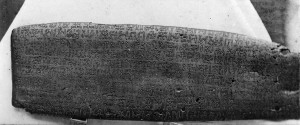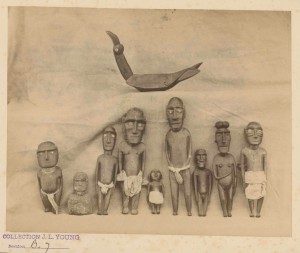Post prepared by Anna Petersen, Assistant Curator of Photographs
Rapa Nui (Easter Island) has never exactly been a popular topic for researchers at the Hocken as far as I know but in 2009, Dr Paul Horley of Yuri Fedkovych Chernivtsi National University in Ukraine wrote to inquire as to whether we had any photographs of rongorongo tablets from this small island on the other side of the Pacific. I began my search feeling far from optimistic and was surprised to find that we hold ten albumen prints of Easter Island artefacts. What is more, one of them turned out to be of exactly what Paul Horley was looking for.
Little over two dozen rongorongo tablets have been documented around the world (some are of questionable authenticity). They are remains of a unique script thought to have evolved on the island sometime between the thirteenth and seventeenth centuries.[1] Catholic missionaries in the mid nineteenth century first recognised their value as evidence of an advanced Polynesian civilisation.[2] By then the indigenous people no longer knew the meaning of the glyphs carved on wood but they called these tablets ‘kohau rongorongo’ or ‘singing wood’[3] and scholars continue to debate their translation.
Dr Horley identified the Hocken photograph as being of the tablet known as Keiti, which has been interpreted in relation to the Rapa Nui lunar calendar in three recent papers published in the Journal de la Societe des Oceanistes in 2011.[4] The original artefact, which measured 39 x 13 cm, was sent by Tepano Jaussen, Bishop of Tahiti, to Europe in 1888 and destroyed in a fire during World War I at the library of l’Université Catholique at Louvain, Belgium.[5]
Just a few original photographs of Keiti remain and how the Hocken came to hold one remains a mystery in itself. Paul Horley, who continues to research the subject, knows of two sets of photographs taken before the tablet was destroyed. ‘One set of photographs was made under direct light with the glyphs filled in with a white substance to improve the contrast (these images are in the collection of the Congregation of the Sacred Hears of Jesus and Mary, Rome). The second set of photographs was made under slanted light, and the photograph that you have, showing the recto side of the tablet, belongs to this set. The other copies of these pictures can be found in the National Anthropological Archives, Smithsonian Institution; Library and Archives of the Bernice P. Bishop Museum, Honolulu; Bancroft Library at the University of California, Berkeley. Some of these images are later prints…’.[6]
One piece of information that we have been able to add to the store of knowledge is that the Hocken photograph of Keiti may have been taken by the photographer Charles Spitz (1857-1894), who had a studio in Papeete. As mentioned above, the print is one of a collection of ten and the mounts of some of the others are stamped with the words ‘Collection of J.L. Young’. James Lyle Young (1849-1929) lived in Papeete from 1882 to 1929 while working in the trading business.[7] He collected and later gave most of the other Easter Island artefacts recorded in the photographs to the Bishop Museum in Honolulu in 1920 and they also hold prints of these. Several of the Hocken photographs reveal parts of Spitz’s studio mark either showing through from the back or shining on the surface.
The collection of Easter Island photographs at the Hocken bear no old accession numbers so one can only guess about how they entered the collection. A possible source was H.D. Skinner, best known as a past Curator and Director of the Otago Museum but also one-time Librarian of the Hocken (1919-1926). The Museum then housed the Library and is another Dunedin institution fortunate enough to hold a Rapa Nui treasure in the form of a moai (large stone statue), registered in 1929.[8]
[1] http://en.wikipedia.org/wiki/Rongorongo (accessed 22 July 2013).
[2] For a comprehensive history see Steven Roger Fischer, Rongorongo, the Easter Island Script: history, tradition, texts, Oxford, 1997.
[3] Werner Wolff, ‘The Mystery of the Easter Island Script’, Journal of the Polynesian Society, 54, no.1 (1945), p.1.
[4] Rafal M. Wieczorek, ‘Astronomical Content in Rongorongo Tablet Keiti’, Journal de la Société des Océanistes, 132 (2011), pp. 5-16; Paul Horley, ‘Lunar calendar in rongorongo texts and rock art of Easter Island’, Journal de la Société des Océanistes, 132 (2011), pp. 17-37; Konstantin Pozdniakov, ‘Tablet Keiti and calendar-like structures in Rapanui script’, Journal de la Société des Océanistes, 132 (2011), pp. 39-74.
[5] Fischer, pp.435-6.
[6] Paul Horley to the writer, email correspondence 10 April 2013.
[7] Biographical note, James Lyle Young – Papers, 1879-1929, State Library of New South Wales online catalogue.
[8] Moira White to the writer, email correspondence 3 May 2013.




Hello, Anna Blackmann,
this is a letter coming from Stuttgart/Germany. I am an artist(painter) and rongorongo – not a script – is my research during the last 25 years. I published in Scientific Journals but now you can read texts on my website, sorry, but in my mother language, german.The photographs of the KEITI are on great interest for my rongorongo research: The quality of the picture on your website is bad, impossible to decipher any of the glyphs.
Do you have better prints and how can I get it?
My best wishes (from the winter on our half of the globe)
Michael H. Dietrich
Researchers can purchase copies of items in the Hocken Collections by contacting us either via email hocken@otago.ac.nz or phone 4798868. Good luch with your research.
Hello, Anna I am interested in the images of the JLY collection( James Lyle Young) at in the Hocken collection. Can you let me know how many images you have and if the material also includes pacific objects other than Easter island?
Hi Ed, If you search the Hocken Snapshop site for Easter Island, you will find images of all the 8-10 J.L.Young collection photographs that we hold. Most of them have a stamp on the mount that also gives a section code. I have gone in and added that information for you to see. I thought it most probably related to an international exhibition at the time but I failed to work out which one. If you find that any of the artefacts are actually from other islands, I would be grateful if you could let me know please. Best wishes, Anna
I am trying to contact Rafal M. Wieczorek. Do you have an email? I have some personal research done on rongorongo I would like to share with him.